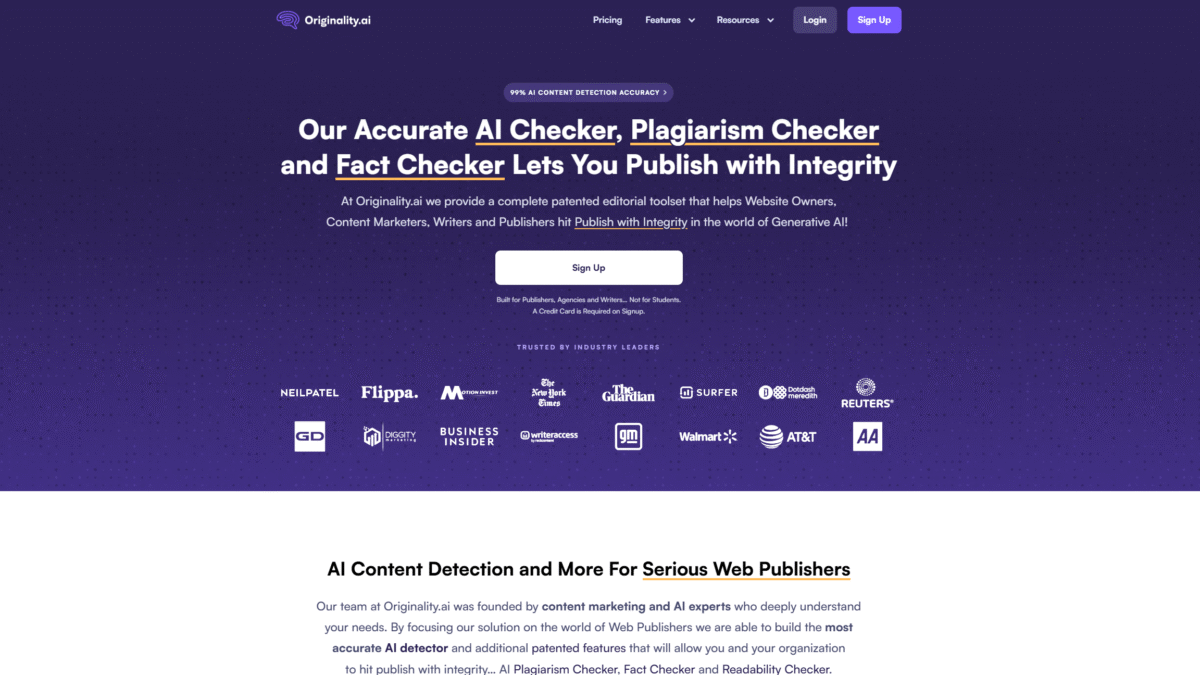
5 Proven Ways to Check for AI Writing in Content
In today’s digital landscape, knowing how to check for ai writing is vital to maintain authenticity and trust in your published content. Whether you manage a blog, run a content agency, or oversee an editorial team, relying on guesswork is no longer enough. To stay ahead, it’s essential to leverage a proven solution like Originality AI. Get Started with Originality AI Today
Why It Matters to Check for AI Writing
Generative AI tools have revolutionized content creation, but they also pose risks. Search engines may penalize purely AI-generated text, readers can lose trust if they suspect inauthenticity, and factual errors—often called “hallucinations”—can harm your reputation. By learning how to check for ai writing, you protect your brand, safeguard SEO performance, and ensure every article reflects genuine human insight.
1. Use a Specialized AI Detection Tool
The most reliable way to check for ai writing is to run your text through a dedicated AI content detector. Generic grammar checkers won’t spot subtle patterns unique to AI models. Originality AI offers the industry’s most accurate detection, distinguishing text generated by ChatGPT, GPT-4, Claude, Llama, Gemini, and others. Its advanced natural language processing models analyze phrasing, syntax, and token patterns that AI tools typically produce.
- High accuracy on paraphrased content
- Multiple sensitivity models for strict no-AI policies or light AI edits
- Batch scanning and full-site reports to audit existing archives
With Originality AI’s API and Chrome extension, you can integrate detection into your workflow and verify authorship in real time.
2. Evaluate Writing Style and Tone
Human writers exhibit natural variation in tone, pacing, and vocabulary. AI-generated passages often read with uniform sentence length, overuse of certain connectors, or overly formal phrasing. To check for ai writing manually, scan for:
- Repetitive sentence structures that lack personal anecdotes or quirks
- Uniform use of transition words (“Moreover,” “Furthermore”) at regular intervals
- Minimal typos or personalized voice markers
Cross-reference stylistic anomalies with known samples from the author. If a section feels too polished or generic, run it through a detection tool before publication.
3. Cross-Verify Facts and Sources
One telltale sign of AI writing is unreliable or invented details. Generative models can fabricate statistics, misquote sources, or cite nonexistent studies. To check for ai writing and guard against inaccuracies:
- Spot-check every statistic using trusted databases or academic journals
- Verify quotes by tracing them to original articles or transcripts
- Confirm hyperlinks point to live, reputable pages
Originality AI’s integrated fact-checking aid streamlines this process by highlighting claims and offering context with source links. You’ll spend less time hunting down references and more time refining insights.
4. Inspect Metadata and Editing History
When content is created manually, metadata can reveal timestamps, revision counts, and IP addresses associated with human editing sessions. AI-generated drafts typically lack this progression. To check for ai writing:
- Review CMS revision logs—multiple minor edits suggest human involvement
- Check file properties for creation and modification dates
- Look for automation tags or comments left by third-party tools
Combining these clues with an AI detection scan provides a clear picture of how your content was produced.
5. Request Transparent Drafting Workflows
Build a culture of accountability by asking writers to share their process. Encourage them to:
- Keep incremental drafts saved in version control
- Use screen-recording extensions or live editing sessions
- Submit research notes and outlines alongside the final copy
When you know exactly how content evolves, it’s much easier to check for ai writing and spot unnatural leaps or contradictions in the narrative.
Integrating AI Checks into Your Workflow
To make AI audits a seamless part of your process, adopt a three-step routine:
- Draft & Self-Review: Writer completes the human draft and self-edits.
- Automated Scan: Run text through Originality AI for AI detection, plagiarism checks, and readability scoring. Try Originality AI for free with the Chrome extension.
- Fact & Style Audit: Editor verifies facts, cross-checks metadata, and ensures tone consistency.
This structured approach reduces last-minute surprises and ensures every piece meets your quality standards.
Key Benefits of Regular AI Writing Audits
- Enhanced Trust: Readers know your content is authentically crafted.
- SEO Protection: Avoid Google penalties related to unverified AI content.
- Time Savings: Automated scans speed up QA without sacrificing accuracy.
- Scalability: Full-site scans let you audit archives and new posts at scale.
Conclusion
Mastering how to check for ai writing safeguards your brand reputation and keeps your content ahead of evolving algorithms. By combining manual checks—like style and fact verification—with an advanced detection platform, you create a foolproof editorial process. Ready to enforce authenticity across every article? Get Started with Originality AI Today
